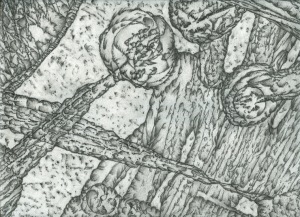Find out about how Max Ernst and others used Frottage.’
Max Ernst 1891-1976, born in Germany was one of the leading surrealists, he had an interest in dream-like imaginary and eccentric imagery. He discovered the technique of frottage in 1925 which gave him a way to express fantasised visions. Frottage is a way of copying and replicating textures from a rough surface by placing a piece of paper over the surface and rubbing it with a medium, for example graphite, pastel or crayon.
http://www.tate.org.uk/art/artists/max-ernst-1065 (accessed 30 April 2014)
Ernst discovered this technique for himself when he found that it was possible to transfer textures onto paper by rubbing with graphite when the patterns in a wooden floor inspired him to try this technique. He also experimented with other rough surfaces such as leaves, bark, thread, netting, and everyday objects. His technique included moving the paper about whilst rubbing and superimposing rubbings on top of one another.
http://www.modernamuseet.se/en/Stockholm/Exhibitions/2008/Max-Ernst/Collage-Frottage-Grattage/ (accessed 30 April 2014)
L’evade 1926
http://www.moma.org/learn/moma_learning/max-ernst-levade (accessed 30 April 2014)
This image is L’évadé (The Fugitive) and is from Histoire Naturelle (Natural History), a book of 34 collotypes (prints), after frottage published in 1926. This particular image shows a variety of different textured surfaces that appear to have been chosen to represent the textures associated with birds and fish or what could represent these animals. This is a fantastical creature could be a sort of cross between a bird and a fish/whale. It appears to be floating either in are or water and the marks made could represent the sea or a patchwork of fields. The tiny mark in the far distance could represent something like a steam ship or a factory. I like the idea of not being able to determine exactly what a mark is meant to be, but to be able to use your imagination to interpret the image as you see it.
I think it is impossible for me to determine how this image has been created as it looks like collage may have been used, but I don’t know.
The image shown in the course notes, Poire, is an interesting composition. The initial impression of the image is that the pear has a larger shadow. Looking closer at the composition, I can see that each pear has its own shadow, suggesting that they are two individual pears. It looks like the larger shadow may have been frottage of a rough skinned pear as the marks appear to be quite subtle.
I have found other artists that use this technique.
Rodger Clark Miller
http://rogerclarkmiller.com/frottagedrawing-2/ (accessed 30 April 2014)
http://rogerclarkmiller.com/frottagedrawing-2/ (accessed 30 April 2014)
Millers drawing style is based on fantasy and imagination and is representative of surrealism. He explored frottage using rough surfaces that came easily to hand with a graphite stick. Some of the rough surfaces gave subtle effects which were difficult to see but nether the less still there. He used an element of improvisation to make discoveries that resulted in the frottage’s to interrelate in a unified manner. These images were enhanced with hand drawing to further establish the meaning of the piece. The hand drawing is usually done very quickly and is referred to as Scrawls.
http://rogerclarkmiller.com/frottagedrawing-2/ (accessed 30 April 2014)
Nicola Ginzel
http://nicolaginzel.com/?noSplash=true (accessed 30/04/2014)
Nicola Ginzel, based in Brooklyn, NYC is a unique artist. Her work is based on taking ordinary everyday objects that we would usually take for granted and changing it to give a different meaning without changing the identity of the object. Her artworks provoke an inquisitiveness about her pieces that makes the viewer think about the original inspiration of the piece.
In some of her pieces, Nicola uses the frottage technique. She creates her own rough surface by embroidering over the writing and images on discarded packaging and objects, for example tickets, maps and cards. From these she uses frottage to create an image. She has different ways in executing the technique in that she may only use part of the rough surface or over laying using different rough surfaces. An example of this is the 2011 graphite frottage (rubbing) 8.5″ x 11″ where I can see at least two rough surfaces, Monochromatic Element No.14 2011 customs sticker embroidered with thread 2″ x 2.75″ and Double Sided-Monochromatic Element No.4 2010 thread, plastic bag, silk organza for backing. I am really inspired by this artist as she has created her own rough surfaces from flat 2 dimensional items and has demonstrated that any medium and support can be used for this technique. She has used graphite on paper, oil pastel on fabric and carried out frottage on a mixed support of fabric and paper. She has inspired me to experiment further with this technique.
I wrote to Nicola Ginzel to ask if I could use her images in my blog and she responded positively and gave me further insight into her work with a written statement describing the processes she has developed and the materials she uses. She said that in the recent published book ‘Playing with Sketches: 50 Creative Exercises for Designers and Artists’ the author, Whitney Sherman coins Nicola’s frottage process as the Ginzel method (pp28 U29).
The images I chose are:
1: Monochromatic Element No.14 2011 customs sticker embroidered with thread 2″ x 2.75″ (accessed 30/04/2014)
2: detail of Monochromatic Element No.14 2011 customs sticker embroidered with thread 2″ x 2.75″ (accessed 30/04/2014)
3: 2011 graphite frottage (rubbing) (accessed 30/04/2014)
4: DETAIL of 8.5″ x 11″ Print 2011 graphite frottage (rubbing) 8.5″ x 11″ (accessed 30/04/2014)
5: Double Sided-Monochromatic Element No.4 2010 thread, plastic bag, silk organza for backing. (Accessed 30/04/2014)
Unfortunately these images are no longer available as Nicola has updated her web site, but there are similar images on her web site.


